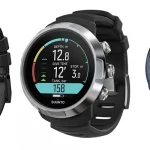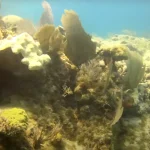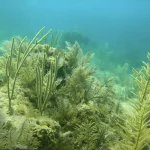Table of Contents
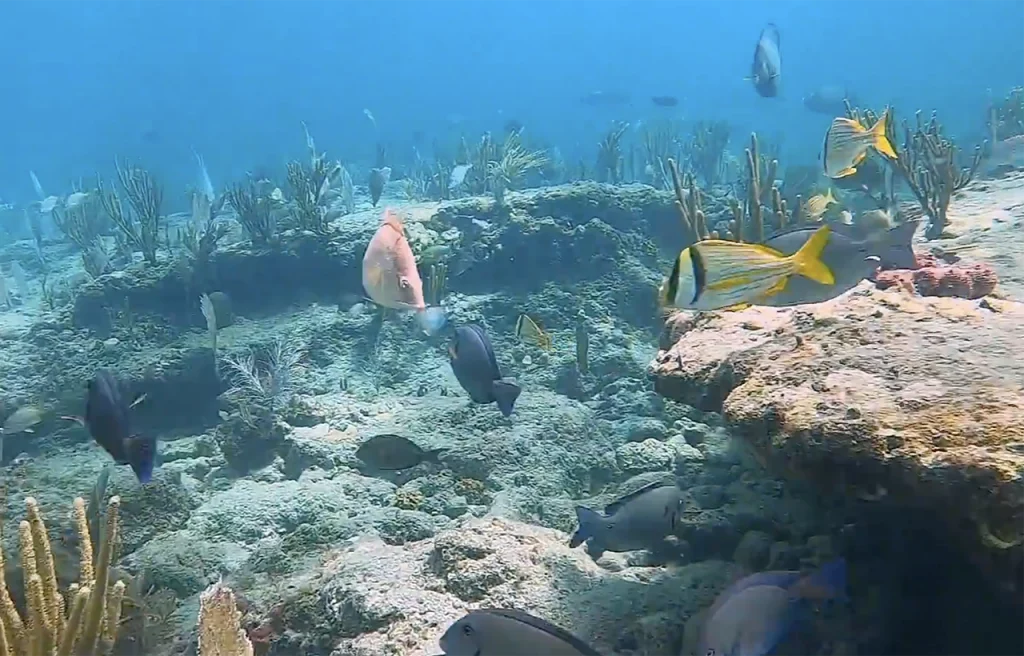
Pompano 3rd Reef Ridge offers an engaging dive experience with rich biodiversity and beautiful underwater scenery, making it a must-visit for diving enthusiasts in Florida.
Article at a Glance
- Diverse Marine Life: Encounter a rich variety of species, including grouper, snapper, lobsters, and vibrant corals, making it a visually stunning dive site.
- Ideal Conditions: Best diving occurs from May to September, with warm water temperatures and visibility often exceeding 60 feet.
- Depth Range: Dives typically range from 45 to 100 feet, accommodating both beginners and advanced divers.
- Drift Diving Opportunities: Enjoy smooth drift diving along the reef, taking advantage of the Gulf Stream currents for an effortless experience.
- Iconic Features: Explore notable spots like the eastern ledge, collapse feature, and the Chimney, which offer unique underwater landscapes.
- Accessibility: The site is suitable for divers of all skill levels, with organized trips and professional guides available through local dive operators.
- Conservation Efforts: Participate in or support local initiatives aimed at preserving the reef ecosystem and enhancing marine biodiversity.
Pompano 3rd Reef Ridge Pompano Beach
- Location: Approximately one mile offshore from Pompano Beach.
- Depth: The reef ranges from 60 to 100 feet deep, making it suitable for divers with varying experience levels.
- Marine Life: The reef features a diverse array of marine species, including colorful corals, basket sponges, and various fish such as grouper. Lobsters can often be found in crevices along the ledges.
Diving Conditions and Navigation
- Best Dive Practices: Divers typically start at either the north hook or the collapse opening at the south end, depending on current conditions. The eastern ledge is recommended for the best experience.
- Current Conditions: The area is influenced by the Gulf Stream, which creates favorable conditions for drift diving. This allows divers to enjoy a smooth and effortless dive along the reef’s features.
Notable Features
- Scenery: The reef is characterized by broken structures and cliffs that provide excellent cover for marine life, enhancing the overall diving experience.
- Nearby Attractions: Pompano Beach is often referred to as the “Wreck Capital” of Florida due to its proximity to numerous wreck dive sites. Divers can also explore other nearby reefs and wrecks during their visit.
What Marine Life Can I Expect To See?
- Coral and Sponges: The reef is home to various types of corals, including hard and soft corals, along with basket sponges, whips, and fans. These provide essential habitats for many marine organisms.
- Fish Species: The area boasts an abundance of tropical fish typical of South Florida reefs. Expect to see:
- Grouper: Large grouper are often spotted along the ledges and outside edges of the reef.
- Snapper: Various snapper species can be found around the reef structures.
- Parrotfish: Known for their vibrant colors and unique beak-like mouths, they are common in these waters.
- Rays and Eels: Look for stingrays gliding along the sandy bottom and moray eels hiding in crevices.
- Invertebrates: The reef also supports a variety of invertebrates, including:
- Lobsters: Commonly found in crevices, especially during their active seasons1.
- Sea Urchins and Starfish: These can often be seen among the coral formations.
- Occasional Sightings: Divers may also encounter larger marine animals such as:
- Sharks: Various species may be spotted in the area, adding an exciting element to the dive experience.
- Dolphins: While less common, dolphins occasionally visit the reef, providing a memorable encounter for divers.
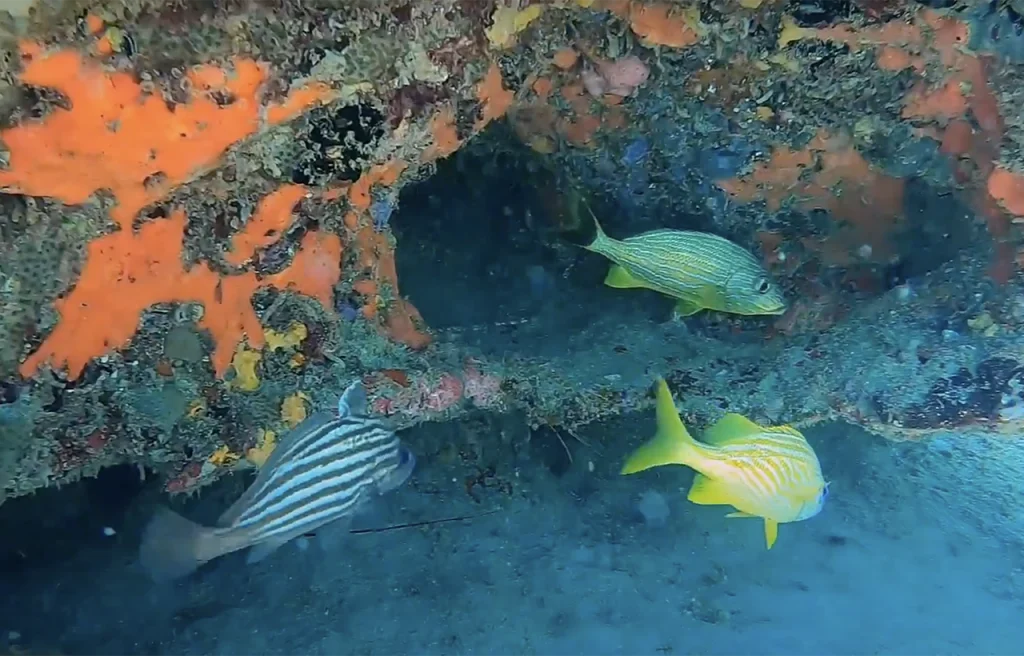
What Do Divers Say About This Site?
Positive Feedback
- Marine Life Diversity: Many divers appreciate the variety of marine life present at the site, including vibrant corals, sponges, and numerous fish species like grouper and snapper. The reef’s structure provides excellent habitats for lobsters and other invertebrates24.
- Scenic Diving Experience: The underwater scenery is often described as beautiful, with broken reef formations and cliffs that enhance the diving experience. Divers enjoy exploring the ledges and crevices where marine life thrives.
- Professional Dive Operations: Reviews frequently mention the professionalism and friendliness of dive operators such as South Florida Diving Headquarters. Many divers feel well taken care of, especially when guides assist with navigation and safety during dives.
Mixed Experiences
- Boat and Shop Operations: While some divers have had excellent experiences with dive shops, others have reported issues such as poor customer service or canceled trips. It’s suggested that divers choose their dive operators carefully to ensure a positive experience.
- Current Conditions: The site is influenced by currents from the Gulf Stream, which can vary. Some divers enjoy drift diving when conditions are favorable, while others may find strong currents challenging.
Key Information
| Category | Details |
|---|---|
| Location | Pompano Beach, Florida |
| Depth Range | 45 to 100 feet (14 to 30 meters) |
| Best Time to Dive | Late Spring to Early Fall (May to September) |
| Visibility | Typically 30 to 60 feet (9 to 18 meters); up to 80 feet in summer |
| Skill Level | Suitable for beginners and advanced divers |
| Dive Type | Drift diving, reef diving |
| Marine Life | Grouper, snapper, lobsters, moray eels, sea turtles, rays, and more |
| Notable Features | Eastern ledge, collapse feature, iconic structures like the Chimney |
| Nearby Attractions | Wrecks such as Quallman Tugs and other dive sites |
| Recommended Dive Operators | South Florida Diving Headquarters, Pompano Dive Center |
| Environmental Conservation Efforts | Coral restoration programs, artificial reefs, marine park initiatives |
Highlights of Diving This Site?
- Rich Marine Life: The reef is teeming with diverse marine species, including vibrant corals, basket sponges, and various fish such as grouper and snapper. Divers often find lobsters hiding in crevices, making it an exciting spot for underwater exploration.
- Scenic Underwater Landscapes: Pompano 3rd Reef Ridge is known for its stunning underwater scenery. The broken reef structure, with its cliffs and ledges, provides excellent cover for marine life and creates a visually captivating environment for divers.
- Ideal Diving Conditions: The site is part of the Florida Reef Tract, the third-largest barrier reef in the world, which allows for year-round diving opportunities. The depth ranges from 60 to 100 feet, accommodating different skill levels and offering drift diving experiences when currents are favorable.
- Navigation Opportunities: Divers can navigate along the eastern ledge or start at specific points like the north hook or collapse opening at the south end, depending on current conditions. This flexibility allows divers to plan their dives effectively and explore various features of the reef.
- Proximity to Other Dive Sites: Being close to numerous wrecks and other reefs enhances the diving experience. Divers can easily combine dives at Pompano 3rd Reef Ridge with visits to nearby wrecks such as the Lady Luck and SS Copenhagen, enriching their underwater adventures.
My Favorite Dive Computers
I have compared the 3 top diving computers for each category to help making the right choice easier:
Iconic Spots At This Site
- The Eastern Ledge: This area is renowned for its stunning underwater scenery and is often recommended as the best dive location. The ledge features various coral formations, providing excellent habitats for marine life, including large grouper and other fish species.
- The Collapse Feature: Located at the southern end of the reef, this unique structure allows divers to navigate through an opening and explore the surrounding areas. It is known for its vibrant marine life and offers a dramatic landscape with cliffs and ledges.
- Lobster Crevices: The outer ledges of the reef are famous for their numerous crevices where lobsters can often be found, especially during the appropriate seasons. This makes it a popular spot for divers interested in lobster hunting.
- Quallman Tugs: Just to the west of Pompano 3rd Reef Ridge, this area includes a series of wrecks known as Quallman Tugs. Divers can start their dive here and then drift towards the reef, experiencing both wreck and reef diving in one excursion.
- The Chimney: This notable feature is characterized by a large hole at the top of the reef, allowing divers to swim through it and emerge on the other side. It is frequently filled with fish, making it a visually captivating spot.
- Moray Eel Hideouts: The reef’s structure provides numerous hiding spots for moray eels, which divers often encounter while exploring. These eels add an exciting element to dives at this site.
Environmental Conservation Efforts
Environmental conservation efforts in Pompano Beach and the surrounding areas focus on protecting marine ecosystems, promoting sustainability, and enhancing public awareness. Here are some key initiatives and projects:
Wahoo Bay Marine Park
- Overview: A new underwater marine park called Wahoo Bay is being developed to serve as a living laboratory for education about ocean ecosystems. It aims to create a mini marine estuary that will be accessible for snorkeling and educational programs, allowing visitors to learn about marine life without needing diving certification.
- SEAHIVE™ System: The park will feature an engineered shoreline protection system called SEAHIVE™, designed to protect against flooding and erosion while providing habitats for marine life. This innovative approach aims to combine environmental protection with ecological education.
Coral Reef Conservation
- Florida Reef Tract: The area is part of the Florida Reef Tract, the third-largest barrier reef in the world, which plays a crucial role in protecting coastlines from storm surges and erosion. Conservation efforts focus on maintaining this vital ecosystem, which supports a diverse array of marine species.
- Coral Nursery Initiatives: Institutions like Nova Southeastern University are working on coral nursery programs to restore endangered coral species and improve coral conservation methods. These efforts are crucial for combating the threats posed by climate change and pollution.
Artificial Reefs
- Creation of Artificial Reefs: Broward County has implemented an artificial reef program that has successfully placed over 76 artificial reefs on the ocean floor. These structures attract marine life and provide additional habitats, helping to alleviate pressure on natural reefs from human activities such as anchoring2.
Beach and Dune Conservation
- Dune Adoption Program: The City of Pompano Beach promotes dune adoption initiatives aimed at preserving natural dunes that protect inland areas from erosion and provide habitats for wildlife. This program encourages community involvement in environmental stewardship.
- Sea Turtle Protection: During nesting season, local regulations help protect sea turtles by minimizing artificial lighting on beaches, which can disorient hatchlings. Community awareness campaigns promote responsible beach behavior to safeguard these species.
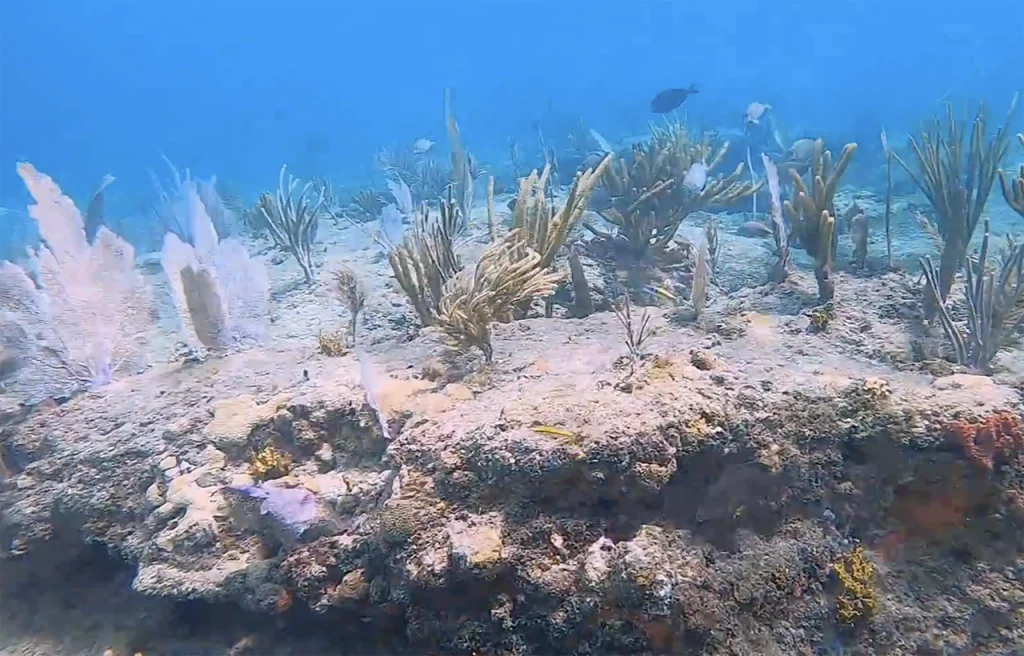
Maximizing Your Diving Experience at Pompano 3rd Reef Ridge
Planning Your Dive
- Choose the Right Time: The best time to dive in this area is from late spring to early fall (May to September) when water temperatures are warmer, and visibility is typically better, ranging from 30 to 60 feet.
- Check Current Conditions: Before diving, check the current conditions. The site is best navigated with a north current, allowing for a smoother drift dive experience. Starting at specific points like the north hook or the collapse opening can optimize your dive based on current direction.
Dive Preparation
- Arrive Early: Arrive at your dive shop at least 30 minutes before departure. This allows ample time for check-in and equipment setup, ensuring a smooth start to your dive trip.
- Select a Reputable Dive Operator: Choose a dive operator known for their professionalism and safety standards, such as South Florida Diving Headquarters. They offer organized dives, equipment rentals, and guided tours that enhance the overall experience.
During the Dive
- Explore Iconic Features: Focus on notable spots like the eastern ledge and the collapse feature, which provide excellent cover for marine life. Look for lobsters in crevices and large grouper along the edges.
- Utilize Drift Diving: Take advantage of the drift diving opportunities that Pompano 3rd Reef Ridge offers. This method allows you to cover more ground effortlessly while enjoying the underwater scenery.
- Be Mindful of Marine Life: Respect the marine environment by avoiding touching corals or disturbing wildlife. Keep an eye out for larger species like sharks and rays, which can occasionally be spotted in the area.
Post-Dive Activities
- Share Experiences: After your dive, engage with fellow divers to share experiences and tips. This community aspect can enhance your understanding of local marine life and diving techniques.
- Consider Additional Dives: If time permits, explore nearby dive sites such as the Quallman Tugs or Pompano Dropoff for a varied diving experience that includes wrecks and different reef structures.
Capturing Memories at Pompano 3rd Reef Ridge: Photography Tips
Equipment Preparation
- Choose the Right Camera: Whether using a compact camera or a DSLR, ensure it is suitable for underwater photography. Use a waterproof housing that allows easy access to controls while diving.
- Use Strobes: Underwater lighting can diminish colors quickly, especially beyond 15 feet. Incorporating one or two strobes can illuminate your subjects and enhance color vibrancy in your photos.
- Lens Filters: Consider using an orange lens filter to reduce the blue light that dominates underwater images, helping to capture colors closer to what you see with the naked eye.
Photography Techniques
- Master Buoyancy Control: Good buoyancy is crucial for stable shots. Practice maintaining neutral buoyancy to avoid disturbing marine life and sediment, which can obscure your images.
- Lighting Techniques:
- Natural Light: In shallow waters (less than 15 feet), utilize natural light by positioning yourself with the sun behind you to effectively illuminate your subjects.
- Artificial Light: For deeper dives, rely on strobes or video lights to enhance visibility and color saturation.
- Composition and Framing:
- Rule of Thirds: Apply this technique to create dynamic images by placing subjects off-center.
- Close-Ups: Focus on details like textures of corals and marine life. Close-up shots can tell compelling stories about the underwater ecosystem.
Timing and Patience
- Wait for the Right Moment: Instead of chasing fast-moving creatures, remain still and allow them to come to you. This often results in more natural photographs.
- Be Ready for Action: Keep your camera settings dialed in for unexpected moments, such as a turtle swimming by or a school of fish passing through.
Post-Dive Review
- Evaluate Your Shots: After diving, review your photos to identify what worked well and what could be improved. This reflection will help refine your technique for future dives.
- Post-Processing: Spend time editing your photos post-dive. Adjusting white balance and contrast can significantly enhance the final images due to particles in the water that may affect clarity.
Frequently Asked Questions
When is the best time to dive Pompano 3rd Reef Ridge?
The best time to dive at Pompano 3rd Reef Ridge is from late spring to early fall, specifically May to September. During this period, water temperatures are warmer, typically ranging from the mid-70s to mid-80s Fahrenheit (approximately 24°C to 29°C), making for comfortable diving conditions.
Visibility is generally at its peak during the summer months, often exceeding 60 feet (18 meters), which is ideal for photography and observing marine life. Additionally, the summer season sees increased marine activity, with many species more visible and active, enhancing the overall diving experience.
While diving is possible year-round, winter months can bring cooler water temperatures and potentially reduced visibility due to seasonal weather patterns. Therefore, planning your dive trip during the warmer months will provide the most enjoyable conditions at Pompano 3rd Reef Ridge.
What is the visibility like while diving Pompano 3rd Reef Ridge?
Visibility while diving at Pompano 3rd Reef Ridge is generally quite good, with typical conditions ranging from 30 to 60 feet (9 to 18 meters). The best visibility occurs during the summer months, often exceeding 60 feet due to calmer seas and less sediment disturbance.
Seasonal variations can affect visibility; for instance, winter months may see decreased clarity due to colder water and potential storms that stir up sediments. However, even during winter, divers can still experience decent visibility on good days. Additionally, the presence of little to no current at Pompano 3rd Reef Ridge contributes to clearer water conditions, making it an enjoyable dive site for both beginners and experienced divers alike.
How deep are the dives at Pompano 3rd Reef Ridge?
Dives at Pompano 3rd Reef Ridge typically range from 60 to 100 feet (18 to 30 meters)deep. This depth makes it suitable for divers with varying levels of experience, though it is generally recommended for those with some level of certification due to the deeper waters involved. The site is part of the Florida Reef Tract, which is known for its vibrant marine life and beautiful underwater landscapes, enhancing the overall diving experience.
Is Pompano 3rd Reef Ridge suitable for beginners?
Pompano 3rd Reef Ridge is suitable for beginners, particularly those who are Open Water Divers or have equivalent experience. The dive site typically features depths ranging from 45 to 60 feet, which is manageable for novice divers under proper supervision and guidance.
The site offers a drift diving experience along a broken reef with excellent visibility and vibrant marine life, making it an enjoyable and safe environment for less experienced divers. Additionally, dive operators in the area, such as South Florida Diving Headquarters, provide organized dives with professional guides who can assist beginners in navigating the reef and ensuring safety throughout the dive.
Is Pompano 3rd Reef Ridge suitable for advanced divers?
Pompano 3rd Reef Ridge can indeed be suitable for advanced divers, but it primarily caters to a wide range of skill levels, including beginners.
Depth and Conditions
Depth Range: The dives at Pompano 3rd Reef Ridge typically range from 45 to 60 feet, which is manageable for advanced divers. However, the site is part of a larger reef system that extends deeper, with other nearby dive sites reaching up to 100 feet. Advanced divers can explore these deeper areas if they choose to venture beyond the 3rd Reef Ridge.
Drift Diving: The site offers excellent drift diving opportunities, which can be particularly appealing to advanced divers looking for a more dynamic experience. The currents can vary, providing challenges that experienced divers often seek.
Marine Life and Exploration
Rich Biodiversity: Advanced divers will appreciate the vibrant marine life and the opportunity to explore complex underwater structures, including ledges and crevices that are home to larger species like grouper and even occasional sharks.
Navigation Skills: The site allows for navigation along the eastern ledge and exploration of various features, making it an engaging dive for those with advanced navigation skills.
Pompano Beach Dive Sites
- Pompano Trench
- Lost Ledge
- Suzzane’s Ledge
- Pompano 3rd Reef Ridge
- Steve’s Twin Ledges
- Shark Reef
- Touchdown Reef
- Pompano Drop Off
- Grouper Bend
- Nursery
- Crab Cove
- Sea Ranch
- Hillsboro Ledge
- Lighthouse Ledge
- Mark’s Ledge
- Moray Bend
- Nolan’s Ledge
- Separated Rocks (Deerfield)
- The Horseshoe
- Abbey Too
- San Remo
- Shark Ledge
- Spotfin Reef

